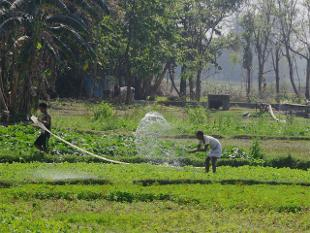
Officials in the ministry of rural development are a happy lot these days. Finance minister Arun Jaitley agreed to practically every demand they made during Budget discussions.
Even the prime minister sat through some detailed presentations, according to a senior ministry official. The result: rural development and agriculture have been the central theme of Jaitley’s budget for 2016-17.
India, into the 70th year of Independence, still struggles to provide basic necessities to all its citizens. More than 70 per cent of its 120 crore population still lives in villages, many of them unconnected by roads, electricity or communications networks. In the Socio Economic and Caste Census (SECC) 2011, about half of the nearly 18 crore rural households reported one or more deprivations such as homelessness, landlessness or being without a literate adult in their families.
More than half the working population in rural areas toiled as casual labour and 30 per cent depended on farming. The highest earner in more than three-fourths of rural households made less than Rs 5,000 a month. Widening fiscal deficit has been keeping government spending on a tight leash. Its expenditure as a percentage of the GDP, a key factor in boosting growth, has fallen from 15.8 per cent in 2009-10 to 13 per cent in 2015-16. Budget numbers show that it will be marginally lower at 12.9 per cent this year. Growth in taxes could have given the government more headroom, but India’s tax-GDP ratio is at 16.7 per cent. In comparison, China’s is 19.4 per cent and the US’ is 25.4 per cent, according to the Heritage Foundation’s 2016 Index of Economic Freedom.
To make matters worse, farmers are struggling. While agriculture’s share in output fell from 28.3 per cent in 1993-94 to 14.4 per cent in 2011-12, its employment share declined from 64.8 per cent to 48.9 per cent over the same period, according to a 2015 paper by NITI Aayog, the think-tank successor of the Planning Commission.
After nearly two years of trying to drive private investment in manufacturing and services, the government returned to tend to rural India, the battered core of the economy that accounts for much of economic demand.
Brushing off earlier misgivings, the finance minister has committed to fund welfare programmes started by the previous government such as the rural job guarantee scheme, village roads building and cheap crop insurance.
The budget measures, Jaitley hoped, would create assets in rural areas and help double farm income in five years. It would take careful planning, technological fixes and capacity building at the grassroots to realise the ambitious target.
While the rural jobs scheme—the Mahatma Gandhi National Employment Guarantee Scheme (MGNREGS)—has been in operation for a decade, it is still plagued by leakages and poor asset creation. In contrast, the rural road building programme, or Pradhan Mantri Gram Sadak Yojana (PMGSY), mandated to construct all-weather roads connecting hitherto unconnected villages and hamlets is doing reasonably well. The project has added lakhs of kilometres of roads, helping farmers to cart their produce to markets and making government services such as education and healthcare slightly more accessible to those living in far-flung areas.
A senior official in the ministry of rural development says the ministry’s focus would be to target “multi-dimensional poverty” as revealed by the SECC 2011. “Now we have data and we can design our interventions accordingly,” he says.
So the government is on Mission Antyodaya, a participatory planning exercise that began last October 2. The idea is to use various schemes such as MGNREGS, national Rural Livelihood Mission, the Deen Dayal Upadhyaya Grameen Kaushalya Yojana, National Social Assistance Programme and the Indira Aawaas Yojana in an integrated manner to alleviate poverty and raise incomes.